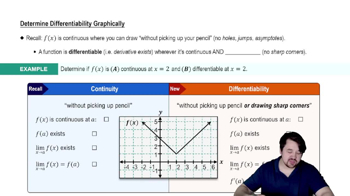Consider the position function s(t)=−16t^2+100t. Complete the following table with the appropriate average velocities. Then make a conjecture about the value of the instantaneous velocity at t=3. <IMAGE>
Table of contents
- 0. Functions7h 54m
- Introduction to Functions16m
- Piecewise Functions10m
- Properties of Functions9m
- Common Functions1h 8m
- Transformations5m
- Combining Functions27m
- Exponent rules32m
- Exponential Functions28m
- Logarithmic Functions24m
- Properties of Logarithms36m
- Exponential & Logarithmic Equations35m
- Introduction to Trigonometric Functions38m
- Graphs of Trigonometric Functions44m
- Trigonometric Identities47m
- Inverse Trigonometric Functions48m
- 1. Limits and Continuity2h 2m
- 2. Intro to Derivatives1h 33m
- 3. Techniques of Differentiation3h 18m
- 4. Applications of Derivatives2h 38m
- 5. Graphical Applications of Derivatives6h 2m
- 6. Derivatives of Inverse, Exponential, & Logarithmic Functions2h 37m
- 7. Antiderivatives & Indefinite Integrals1h 26m
- 8. Definite Integrals4h 44m
- 9. Graphical Applications of Integrals2h 27m
- 10. Physics Applications of Integrals 3h 16m
- 11. Integrals of Inverse, Exponential, & Logarithmic Functions2h 31m
- 12. Techniques of Integration7h 41m
- 13. Intro to Differential Equations2h 55m
- 14. Sequences & Series5h 36m
- 15. Power Series2h 19m
- 16. Parametric Equations & Polar Coordinates7h 58m
1. Limits and Continuity
Introduction to Limits
Problem 18d
Textbook Question
Use the graph of in the figure to find the following values or state that they do not exist. If a limit does not exist, explain why. <IMAGE>
limx→2g(x)
 Verified step by step guidance
Verified step by step guidance1
Examine the graph of g(x) around x = 2 to understand the behavior of the function as x approaches 2 from both the left and the right.
Identify the left-hand limit, \( \lim_{x \to 2^-} g(x) \), by observing the values that g(x) approaches as x approaches 2 from the left side.
Identify the right-hand limit, \( \lim_{x \to 2^+} g(x) \), by observing the values that g(x) approaches as x approaches 2 from the right side.
Compare the left-hand limit and the right-hand limit. If both limits are equal, then the limit \( \lim_{x \to 2} g(x) \) exists and is equal to this common value.
If the left-hand limit and the right-hand limit are not equal, then the limit \( \lim_{x \to 2} g(x) \) does not exist, and you should explain that the discrepancy between the two limits is the reason for the non-existence.
 Verified video answer for a similar problem:
Verified video answer for a similar problem:This video solution was recommended by our tutors as helpful for the problem above
Video duration:
5mPlay a video:
Was this helpful?
Key Concepts
Here are the essential concepts you must grasp in order to answer the question correctly.
Limits
A limit is a fundamental concept in calculus that describes the behavior of a function as its input approaches a certain value. It helps in understanding the function's value at points where it may not be explicitly defined. For example, the limit of g(x) as x approaches 2 examines how g(x) behaves near x = 2, which is crucial for determining continuity and differentiability.
Recommended video:

One-Sided Limits
Continuity
Continuity of a function at a point means that the function is defined at that point, the limit exists, and the limit equals the function's value at that point. If g(x) is continuous at x = 2, then the limit as x approaches 2 will equal g(2). Discontinuities can arise from jumps, holes, or vertical asymptotes, affecting the existence of limits.
Recommended video:

Intro to Continuity
Graphical Interpretation
Graphical interpretation involves analyzing the visual representation of a function to understand its behavior. By examining the graph of g(x), one can identify limits, continuity, and points of discontinuity. This visual approach aids in determining whether the limit as x approaches 2 exists and provides insight into the function's overall behavior near that point.
Recommended video:

Determining Differentiability Graphically

 6:47m
6:47mWatch next
Master Finding Limits Numerically and Graphically with a bite sized video explanation from Patrick
Start learningRelated Videos
Related Practice
Textbook Question
